The Role of Urban Gardens in Dubai's Development
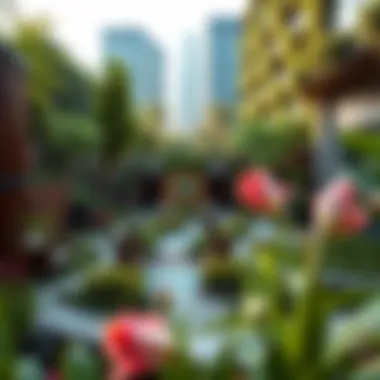
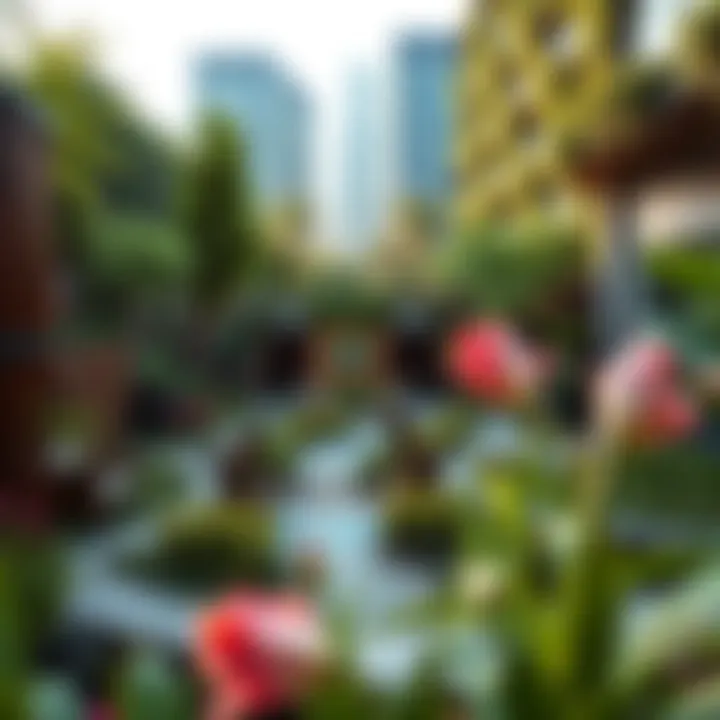
Intro
Urban landscapes are often synonymous with concrete jungles, skyscrapers, and relentless activity. However, in a bustling city like Dubai, gardens are increasingly carving out their place in this environment, turning the harsh in to a harmonious blend of nature and urban life. This article embarks on a journey through the evolving landscape of gardens in Dubai, examining how these green spaces not only beautify the city but also foster community ties and contribute to ecological sustainability.
As Dubai continues to grow at a breakneck pace, integrating green spaces into urban planning has become more than a trend; it’s a necessity. From the sprawling Dubai Miracle Garden, which showcases an impressive variety of plants in artistic designs, to community gardens sprouting up throughout neighborhoods, gardens in Dubai are proving their worth in enhancing the living experience for residents and visitors alike.
In a city renowned for its innovation and wealth, the challenge lies in balancing the rapid urban development with nature's presence. This article will highlight the growing importance of gardens in urban Dubai, offering a detailed look into the current market trends, property insights, and future projections.
Through careful analysis, we aim to provide a comprehensive understanding of how gardens are interwoven with Dubai's bustling landscape while addressing both the challenges and the opportunities that lie ahead.
Preface to Urban Gardens
The evolution of urban gardens is no small feat, especially in the bustling cityscape of Dubai, where the demand for space often contradicts the desire for greenery. Understanding urban gardens is crucial because they offer numerous benefits that enhance not just visual appeal but also ecological and social stability. In a world where concrete dominates, these green oases serve as vital counterpoints, inviting nature back into our lives and providing essential life support systems, even in the most developed urban environments.
The intricate relationship between built environments and nature has far-reaching implications. Urban gardens can significantly improve air quality, support biodiversity, and provide spaces for community interaction. As Dubai continues to flourish, assessing how urban gardens fit into the landscape is paramount to creating a sustainable future.
Defining Urban Gardens
Urban gardens can be broadly defined as green spaces situated within city limits, established with various purposes ranging from aesthetic enhancement to food production and ecological support. These gardens are not mere patches of grass; they encompass community gardens, vertical installations, green roofs, and much more. They provide a patch of soil where people can plant flowers and herbs, or even larger areas where community members can cultivate vegetables. The essence of an urban garden lies in its capacity to bring people and nature closer together while embodying the principles of sustainability and biodiversity.
Historical Context of Gardens in Urban Environments
Historically, gardens have held an essential place in urban planning, evolving alongside the cultures and eras that shaped cities. In ancient civilizations, gardens were often a reflection of social status and aesthetic values—think of the exquisite hanging gardens of Babylon or the tranquil courtyards in Islamic architecture, which symbolized harmony and introspection.
With the industrial revolution came a shift in focus toward utilitarian development, sidelining green spaces in favor of factories and residences. However, the 20th century saw a resurgence of interest in gardens, propelled by a growing understanding of their importance in urban society. Cities like London and New York began recognizing the need for public parks, setting the stage for initiatives that would prioritize green spaces alongside urban development.
In Dubai, the quest for gardens is relatively new. With the city emerging as a modern marvel, laying emphasis on luxurious skyscrapers and expansive malls, the integration of gardens serves not just as an aesthetic embellishment but also as an essential element of urban life. The city's unique blend of cultural influences from West and East plays a significant role in defining what urban gardens can represent in a modern context.
"Urban gardens should not just be seen as places to beautify; rather, they stand as pivotal components of urban resilience and community ethos."
As we delve deeper into the significance of gardens within Dubai, we must acknowledge the historical interplay between nature and urban planning, understanding how past trends have shaped contemporary green spaces. Emphasizing this historical context provides key insights into how gardens can be effectively integrated into an ever-evolving urban landscape, making them indispensable not just for aesthetic reasons but also for ecological and social sustainability.
The Role of Gardens in Dubai
The introduction of gardens into urban settings in Dubai has happened alongside a rapid expansion and heightening urban development. These green areas are not merely a touch of natural beauty but serve a multitude of functions that significantly elevate the overall quality of life in this industrious city. Gardens in Dubai are increasingly recognized for their multi-dimensional contributions, ranging from aesthetic enhancement to ecological balance and cultural connectivity.
Enhancing Urban Aesthetics
Urban spaces can often feel sterile and overwhelming due to concrete structures and relentless development. However, gardens soften this hard-edged environment, offering a much-needed respite for residents and visitors alike. Imagine strolling through a lush oasis like the Dubai Miracle Garden, where an array of colorful flowers creates visually stunning displays that capture the imagination.
The careful design of these spaces, utilizing flowering plants, trees, and structured greenery, contributes tremendously to the aesthetic appeal of the landscape. It elevates neighborhoods not only visually but also emotionally, as people are drawn to spaces that resonate with nature. Individuals are known to gravitate toward visually pleasing locations to relax and unwind, effectively turning even mundane daily commutes into serene experiences. Gardens thus become a canvas for creativity, displaying artistic endeavors through installations and gardening techniques that express the innovative spirit of Dubai.
Promoting Biodiversity
In an urbanized setting like Dubai, the conservation of biodiversity is crucial. Gardens provide habitats for various species, ranging from birds to insects, promoting a healthy ecological balance. Many urban gardening initiatives have implemented native and adaptive plant species to blend seamlessly with local fauna, encouraging wildlife to thrive in a city characterized by its rapid development.
By reintroducing native flora into urban landscapes, these gardens help mitigate the negative impacts of urban sprawl. Gardens can serve as green corridors, enabling wildlife movement across fragmented landscapes. This method is particularly beneficial in areas grappling with environmental stressors, such as pollution or climate change.
- Importance of Biodiversity in Gardens:
- Supports local wildlife
- Enhances ecosystem functions
- Provides educational opportunities for communities
Cultural Significance of Green Spaces
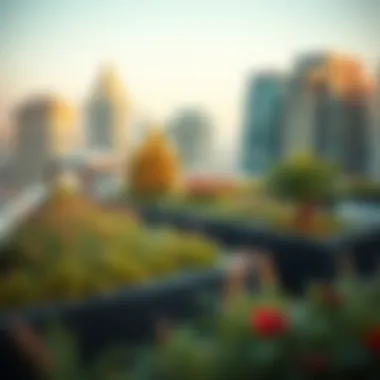
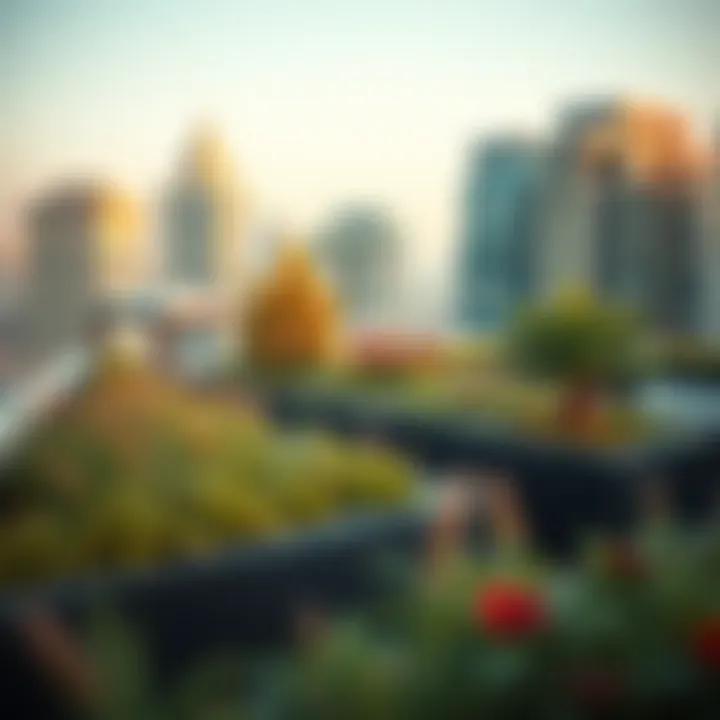
Gardens are more than just patches of greenery; they represent cultural narratives and community bonds. In Dubai's diverse society, these spaces serve as meeting points for people from various backgrounds, fostering interactions and relationships. Through community gardening projects, residents gain the opportunity to connect with each other, sharing knowledge and experiences.
Moreover, gardens also reflect the traditional values of Emirati culture, with historical references to public gardens serving as spaces for gatherings and socializing. The incorporation of cultural themes into garden design not only enhances the aesthetic value but also serves to educate visitors about the region's rich heritage.
"Gardens in Dubai are vital not only for enhancing landscapes but also for weaving the cultural and social fabric of the community together."
In sum, gardens hold a fundamental role in Dubai, acting as essential components of urban design that provide benefits across aesthetics, biodiversity, and cultural connections. These green havens not only beautify the landscape but are integral to improving the urban experience in a city that is constantly evolving.
Types of Gardens in Dubai
The significance of garden diversity in Dubai plays a pivotal role in reshaping the urban landscape. Each type of garden offers unique benefits that contribute to both the community and ecosystem. Adapting garden styles to the unique challenges of the desert environment fosters resilience and promotes a healthier urban experience for residents and visitors alike. From community-centric spaces to private sanctuaries, the variety of gardens is integral to Dubai’s identity.
Public Parks and Community Gardens
Public parks and community gardens in Dubai serve as vibrant hubs for social interaction and ecological sustainability. These spaces are often equipped with amenities like walking paths, playgrounds, and areas for sports, catering to the needs of families and individuals alike. They provide a necessary respite from the fast-paced urban life, creating an oasis where inhabitants can unwind and connect with nature.
Community gardens in particular offer a unique chance for residents to cultivate their own plants, fostering a sense of community spirit and collaboration. They allow people to come together, share knowledge, and grow food, which not only enriches diets but also strengthens community bonds. The involvement of diverse cultural groups often leads to the exchange of gardening techniques and culinary traditions, adding a dash of multiculturalism to these green spaces.
"The best investment on Earth is earth."
- Louis Glickman
These gardens play a crucial role in enhancing local biodiversity. By planting native species, they support local wildlife and help maintain ecological balance. Moreover, the presence of greenery in urban areas can mitigate the urban heat island effect, a warmer microclimate caused by concrete and buildings. This makes public parks vital for both residents’ comfort and the sustainability of the local environment.
Private Gardens in Residential Developments
Private gardens in residential complexes have become increasingly popular among developers and homeowners in Dubai. They offer not just aesthetic value, but also a personal retreat for individuals and families. These gardens fulfill a longing for connection to nature, providing a green escape right outside one's door. Homebuyers are now looking for properties that include these outdoor spaces, recognizing their impact on quality of life.
Having a private garden allows for customization based on individual preferences. Homeowners can decide on plant selections, garden layouts, and personal touches, making it a truly personal space. Many private gardens are designed to utilize native plants which requires less water, ideal for the region's arid climate. This not only conserves water but also reduces maintenance costs, making them a practical choice for homeowners.
Innovative designs often incorporate features like shaded patios, water features, or even small vegetable patches, which not only enhance the experience of the space but also promote sustainability and food security. In a city bustling with high-rises and commercial centers, these gardens offer a slice of tranquility, allowing residents to unwind after a hectic day.
Vertical Gardens and Rooftop Spaces
With space at a premium in urban Dubai, vertical gardens and rooftop spaces present an ingenious solution for incorporating greenery into the densely built environment. These gardens, often referred to as green walls, maximize the use of limited ground space while still creating a visually appealing atmosphere. They are becoming popular in both commercial buildings and private residences, yielding several ecological and aesthetic benefits.
Rooftop gardens provide not only a stunning view of the city skyline but also an opportunity for urban farming. Utilizing hydroponics or other modern gardening techniques, residents can grow fresh produce right at their doorstep. This not only contributes to self-sufficiency but also lowers the carbon footprint associated with transporting food.
Vertical gardens improve air quality by filtering pollutants and increasing oxygen levels. They can significantly reduce energy costs for buildings, providing natural insulation. By absorbing sunlight and reducing heat absorption, these gardens help regulate temperatures within buildings.
As urban areas continue to grow, the importance of innovative gardening solutions will only rise. Incorporating vertical and rooftop gardens into Dubai's architectural landscape is essential for a sustainable future, marrying urban living with nature seamlessly.
Gardens and Sustainability
The topic of gardens and sustainability is pivotal in exploring how urban landscapes, particularly in a dynamic city like Dubai, can coexist with nature. As urbanization continues to sweep across the globe, integrating green spaces into the concrete jungles is critical. Gardens offer a multifaceted approach to sustainability—through various innovative practices, they can harmonize natural ecosystems with urban development. Not only do they beautify the surroundings, but they also serve practical purposes in water conservation, support local biodiversity, and enhance the overall resilience of urban environments.
Water Conservation in Garden Design
Water scarcity is an ongoing challenge in Dubai, a city that lies largely within the arid desert. Therefore, thinking about water-efficient garden design is not just smart; it’s essential. Implementing systems like drip irrigation can significantly reduce water waste while ensuring that plants receive necessary hydration. Additionally, using techniques such as mulching helps conserve moisture in the soil, reducing evaporation and providing essential nutrients as it breaks down.
It’s also worth noting that collecting rainwater is a growing trend among gardeners in Dubai. Systems that capture rainwater for irrigation purposes can drastically lower water consumption and lessen the burden on municipal resources. Not only does this practice reflect a commitment to sustainability, it helps mitigate the risk of flooding during unexpected downpours.
Using Native Plants for Eco-friendliness
Opting for native plants is a surefire way to bolster the eco-friendliness of urban gardens in Dubai. These plants are adapted to the local climate, requiring significantly less water and maintenance than exotic species, which often struggle to thrive in harsh, dry settings. For instance, species like the ghaf tree and various types of desert wildflowers are not only resilient but also play crucial roles in the local ecology.
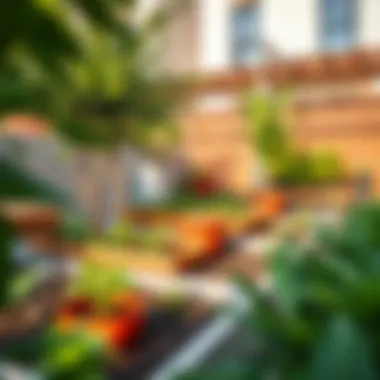
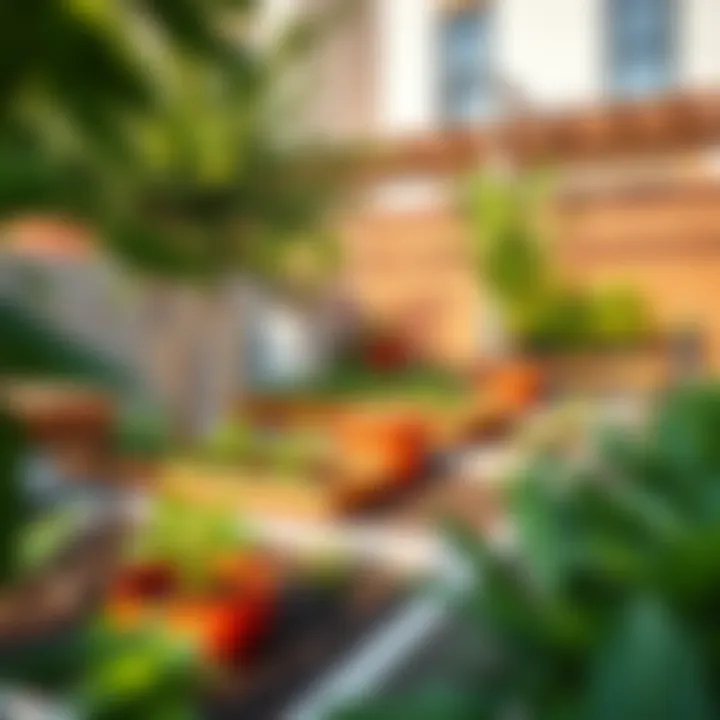
The use of native plants also supports local wildlife, providing habitat and nutrition for birds and insects. Moreover, when communities choose to plant native vegetation, they create a stronger connection to their environment. This sense of place enhances cultural identity while promoting an appreciation for the natural heritage of the region.
Active Role in Climate Resilience
As climate change poses an increasing threat to urban settings, gardens can act as frontline defenders against its impacts. They help improve air quality by filtering pollutants and capturing carbon dioxide, which is particularly vital in densely populated areas like Dubai. Additionally, gardens enhance urban heat resilience; they provide shaded areas that cool down surrounding spaces, thus helping to mitigate the Urban Heat Island effect.
Furthermore, the presence of gardens can promote mental health benefits by offering green spaces where residents can unwind and connect with nature. This relationship with greenery has shown to reduce stress levels, enhancing overall well-being.
As more people realize these benefits, urban gardens will continue to play a critical role in fostering an adaptive, resilient urban environment—one that can not only withstand climate challenges but also thrive in their midst.
"Gardens are the beginning of the world. They represent the environmental oasis we need amid the bustle of urban life."
Innovative Design Trends
Innovative design trends in urban gardens are carving out a new narrative in Dubai, blending modern technology with artistic vision and community spirit. As the city grapples with rapid urbanization, these trends are not just aesthetic choices; they redefine how green spaces are perceived, managed, and integrated into daily life. Emphasizing sustainability and engagement, they offer solutions to some of the complexities that come with densely populated urban settings.
Integrating Technology in Garden Management
The integration of technology in garden management is revolutionizing how urban gardeners maintain their patches of greenery. Smart irrigation systems, for example, utilize sensors that determine soil moisture levels. This ensures that plants get just the right amount of water, conserving precious resources while optimizing growth.
Moreover, mobile applications can track plant health, providing timely alerts for necessary care or pest control. Urban gardeners can engage in real-time monitoring, allowing them to take action before problems escalate. Such technological advancements ensure that even in limited spaces, gardens can thrive, adding a dash of green to the concrete jungle.
- Key Technologies in Urban Gardening:
- IoT-based soil monitoring systems
- Automated irrigation systems
- Plant health tracking apps
The adoption of technology not only enhances the practicality of gardening in limited spaces but also fosters a sense of connectedness among community members who share resources, tips, and experiences.
Artistic Elements in Garden Design
Artistic elements are another significant aspect of contemporary gardens. They are where functionality meets creativity. In Dubai, landscape architects are weaving local culture and contemporary art into garden designs. Stunning mosaics, sculptures, and carefully selected plant varieties come together to create visually appealing green spaces that tell a story.
- Elements of Artistic Garden Design:
- Custom sculptures reflecting local art
- Unique plant arrangements that create visual geography
- Pathways that guide visitors through immersive experiences
Such artistic flair not only enhances the beauty of urban gardens but also invites cultural contemplation and a deeper appreciation of the environment. It influences how residents and visitors interact with these spaces, transforming a simple stroll into an enriching experience.
Community Engagement through Gardening Projects
Community engagement is imperative in making urban gardens successful and sustainable. They are no longer mere patches of greenery but thriving ecosystems fueled by local collaboration. Gardening projects that involve community members foster a sense of ownership and responsibility; it’s about bringing people together with a common goal.
Initiatives like community gardening days or workshops on sustainable practices encourage participation and education about the importance of green spaces. They instill pride and a collective history among residents. In Dubai, several neighborhood gardens collaborate, sharing resources and ideas, ensuring a vibrant community spirit.
"Community gardens turn strangers into neighbors."
Organizations and local governments often provide support through grants or resources, further facilitating these projects. In doing so, they transform neglected areas into lush landscapes, creating valuable social interactions and boosting local biodiversity.
The End
In essence, the innovative design trends shaping gardens in Dubai are not merely about aesthetics; they encompass a larger dialogue regarding sustainability, technology, and community resilience. Whether through the seamless integration of smart solutions, the infusion of artistic elements, or enhancing engagement within the community, these trends pave the way for a greener and more livable urban landscape.
Challenges Facing Urban Gardens
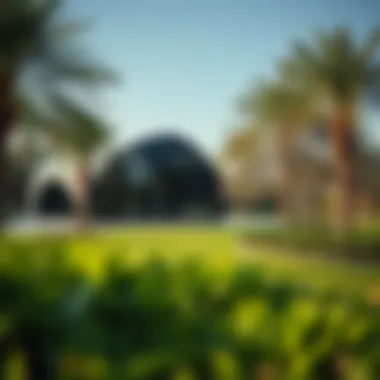
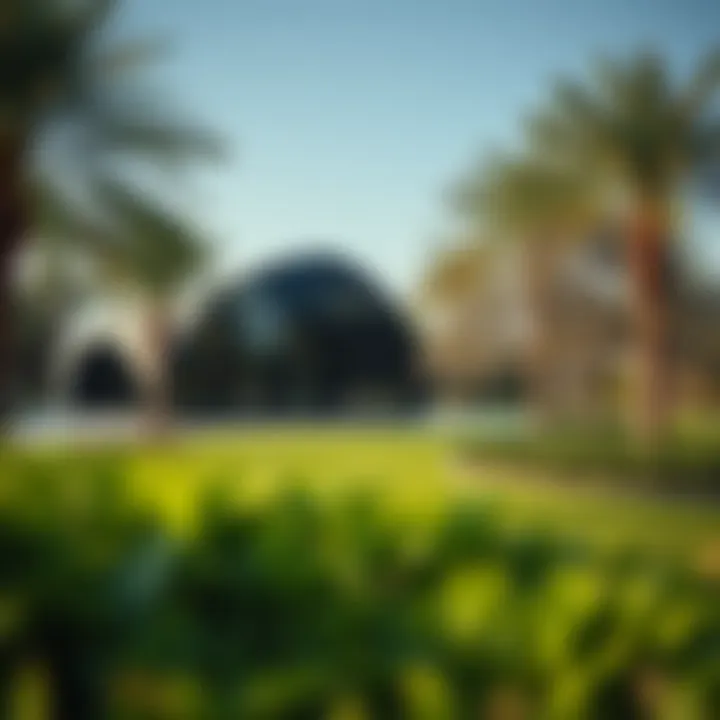
Urban gardens play a crucial role in the fabric of city life, but they are not without their hurdles. In Dubai, a city characterized by rapid development and growing population density, these gardens face unique challenges that warrant exploration. Understanding these difficulties is essential for progress in integrating green spaces within the urban environment. By analyzing issues like limited space, land use conflicts, and environmental stressors, one can better appreciate the delicate balance that gardens must maintain amidst the bustling backdrop of urban Dubai.
Limited Space and Land Use Conflicts
Space in Dubai is a rare commodity, often leading to fierce competition for land among various uses, including residential, commercial, and recreational. Urban planners and developers are grappling with how to efficiently balance these conflicting needs. In particular, the challenge lies in incorporating green spaces without compromising other critical infrastructure developments.
The solution is not straightforward. Many neighborhoods prioritize high-rise buildings, shopping complexes, or expansive roads over gardens. This has resulted in a scarcity of spots reserved for greenery, making existing urban gardens feel like hidden gems amidst the concrete jungle. Moreover, as demand for housing and commercial properties surges, there’s constant pressure to convert even minor patches of vegetation into usable plots.
"In a city where the skyline seems to compete with nature, gardens become the underdog - valued yet often overshadowed by steel and glass."
Community gardens and public parks can provide a respite from this struggle, fostering social interactions and biodiversity. However, their development often comes with an uphill battle. Local governments need to advocate for policies that explicitly allocate space for gardens. Initiatives like 'pocket parks' strive to reclaim every inch available for greenery, yet these efforts must further go hand-in-hand with community awareness to resonate with residents and stakeholders alike.
Environmental Stressors: Pollution and Heat
Dubai's urban setting also subjects gardens to significant environmental stressors, primarily pollution and extreme heat. As the city boasts one of the highest population densities and a wealth of vehicular traffic, air quality can compromise both human health and the vitality of plant life. Gardens become intricate ecosystems, requiring careful management to thrive in such an environment.
Pollution can stifle plant growth, alter soil quality, and complicate water sources. In more severe instances, it can lead to reduced biodiversity, as certain species struggle to adapt to harsher conditions. Additionally, contamination from nearby industrial activities can adversely affect urban gardening initiatives, making it imperative for developers to ensure the integrity of soil and air quality.
On the other hand, the scorching heat presents another layer of complication. While Dubai's environment is home to various native plant species, sustaining a garden during the peak summer months often becomes a daunting task. For instance, turf and other traditional garden staples may find it hard to flourish under such climates, leading many residents to abandon garden plans altogether.
This brings about a pressing need for thoughtful design. Opting for drought-resistant plants, implementing shaded structures, and utilizing innovative irrigation techniques can provide solutions that enable urban gardens not just to survive, but to thrive. Emphasizing these methods can yield green spaces that withstand Dubai's challenging climate while enriching the community.
Future Perspectives
The future of gardening in urban Dubai is not merely a trend; it reflects a growing awareness of the necessity for green spaces amid expanding concrete jungles. As the city continues to transform, expectations for gardens must adapt as well. In this section, the focus will be on how policies can play a pivotal role in enhancing urban greenery, alongside emerging trends that redefine modern gardening practices.
The Role of Policy in Promoting Green Spaces
Urban policies are the framework that guides the integration of gardens in densely populated areas. For many cities, including Dubai, the government's commitment to green initiatives is fundamental. Regulations and incentives can provide the necessary support for creating and maintaining parks and gardens, making way for a landscape that fosters both environmental health and community well-being.
- Zoning Regulations: Policies must prioritize the allocation of land for parks and community gardens. Zoning laws can create protected areas that ensure these spaces remain untouched by future residential or commercial developments.
- Funding and Grants: Government can allocate funds specifically for the development of urban gardens. Grants for projects that focus on sustainability and community engagement encourage local partnerships.
- Public Engagement Initiatives: Engaging the community in the decision-making process can boost the significance of green spaces. Through public forums and workshops, residents can express their needs and desires for local gardens, leading to an environment that reflects the community’s identity.
"Gardens are not merely decorative elements; they are the heartbeats of urban life, essential in maintaining the well-being of the citizenry."
By understanding the importance of pro-active policies, stakeholders can ensure a cooperative approach that recognizes the essential role of greenery in urban settings.
Expected Trends in Gardening Practices
The anticipated changes in gardening practices within urban Dubai are shaped by several factors, including sustainability, technology, and the community’s evolving preferences. These trends are likely to influence how residents interact with their environment.
- Sustainable Practices: With climate challenges escalating, more gardeners are looking towards sustainable practices. This can include the use of natural pest control and organic fertilizers. Residents may also focus on permaculture techniques that develop resiliency in urban gardens.
- Integration of Technology: Advances in technology are transforming traditional gardening methods. From automated irrigation systems to smart gardening apps, technology streamlines plant care and enhances productivity. Urban dwellers may use sensors to monitor soil moisture or temperature, optimizing their gardening efforts.
- Fostering Palestinian Culture: As Dubai becomes increasingly multicultural, gardening practices may reflect its diverse population. Community gardens can spring up featuring crops from various cultures, allowing an exchange of knowledge and traditions while enhancing social bonds among residents.
Gardens are set to emerge as symbols of progress in urban life, merging modernized features with the rich heritage of community. Thus, the future of gardening in Dubai is bright with potential, where creativity, sustainability, and technology all play pivotal roles in shaping this evolving landscape.
The End: The Vitality of Gardens in Urban Dubai
Gardens in urban Dubai are not just mere patches of greenery; they are lifelines in an environment that can often feel overly concrete and unwelcoming. As cities evolve into bustling hubs of activity, the integration of gardens plays a critical role in enhancing the quality of urban life. These spaces foster a connection with nature, allowing residents and visitors alike to find respite from the fast-paced atmosphere of city living. It's in these quiet corners where individuals can take a moment to breathe, understand the importance of biodiversity, and appreciate the beauty that nature brings to an otherwise rapidly developing landscape.
Summary of Key Insights
Throughout this exploration, several key elements emerge, underscoring the significance of gardens in urban Dubai:
- Aesthetic Enhancement: The visual appeal of parks and gardens softens the harsh lines of urban architecture, providing a welcome contrast and enriching the aesthetic experience for all who traverse the city.
- Ecological Role: Urban gardens contribute to improved air quality and biodiversity. They act as vital habitats for various species, offering a refuge amidst the concrete jungle.
- Cultural Connections: Gardens often serve as cultural symbols and community gathering spaces where local traditions can flourish, promoting a sense of belonging and providing social benefits.
- Resilience and Sustainability: As climate challenges continue, these green spaces offer opportunities for innovative practices that encourage sustainability and resilience in urban planning.
These insights build a compelling case that gardens are not just an afterthought in the urban landscape but essential components that improve overall livability.
Call for Continued Advocacy for Green Spaces
The call for continued advocacy for green spaces is crucial as urban areas continue to expand and develop. Policymakers, city planners, and community members must prioritize the integration of gardens into future developments.
- Policy Development: Local governments need to adopt and enforce policies that protect existing green spaces while incentivizing the creation of new ones.
- Community Involvement: Advocating for community-based gardening initiatives can empower residents to take ownership of these spaces, ensuring they meet local needs and cultural contexts.
- Investment and Innovation: Encouraging investment in innovative garden designs and sustainability practices can further enhance the resilience of urban gardens, making them adaptable to changing environmental conditions.













